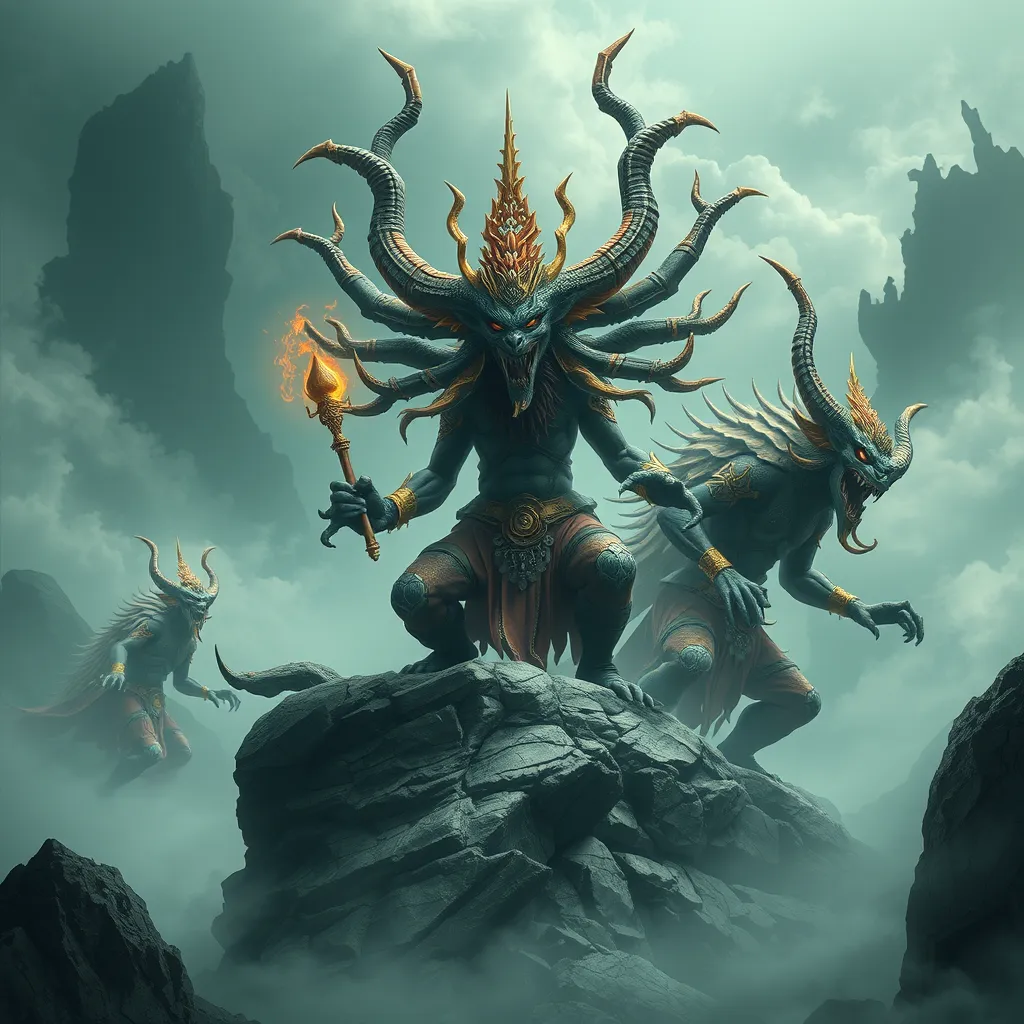The Rakshasa in Malay Mythology: The Guardians of the Sacred Mountains
I. Introduction
Malay mythology is a rich tapestry of beliefs, stories, and cultural practices that have evolved over centuries. It encompasses a variety of supernatural beings, legendary heroes, and moral tales that reflect the values and traditions of the Malay people. Among the most fascinating figures in this mythology is the Rakshasa, a creature with origins steeped in ancient lore.
This article aims to explore the Rakshasa’s role within Malay mythology, highlighting its origins, characteristics, and significance as guardians of sacred mountains. By examining these aspects, we can better understand the cultural identity of the Malay people and the enduring legacy of their myths.
II. Origins of the Rakshasa in Malay Culture
The Rakshasa has historical roots that can be traced back to Indian mythology, where it is often depicted as a demon or spirit with malevolent intentions. However, the Malay interpretation of the Rakshasa has evolved over time, incorporating indigenous beliefs and practices.
- Historical roots and influences from Indian mythology: The arrival of Hinduism and Buddhism in the Malay Archipelago brought with it a wealth of mythological narratives, including those of the Rakshasa. These influences can be seen in early Malay literature and folklore.
- Evolution of the Rakshasa figure in Malay folklore: Over time, the Rakshasa transformed from a fearsome demon into a more complex figure that embodies both protective and destructive qualities. This duality reflects the importance of balance in Malay culture.
- Symbolism and cultural significance: The Rakshasa symbolizes the guardianship of sacred spaces, particularly mountains, which are considered sacred in Malay tradition.
III. Characteristics of the Rakshasa
The Rakshasa is often depicted with distinctive physical traits and behavioral attributes that set it apart from other mythological beings.
- Physical descriptions and attributes: Rakshasas are commonly described as having fearsome appearances, with sharp teeth, wild hair, and a towering stature. Their forms can be both human and animalistic, showcasing a shape-shifting ability.
- Traits and behaviors commonly associated with Rakshasa: They are often portrayed as cunning, deceptive, and capable of both benevolence and malice. While they can act as protectors, they are equally feared for their potential to cause chaos.
- Variations in portrayal across different regions: The depiction of Rakshasa varies significantly across the Malay Archipelago, influenced by local cultures and beliefs. Some regions view them as malevolent spirits, while others see them as wise guardians.
IV. The Role of Rakshasa as Guardians
In Malay tradition, Rakshasas hold a significant role as guardians of sacred mountains, which are often seen as the dwelling places of deities and spirits.
- Relationship with sacred mountains in Malay tradition: Mountains are revered in Malay culture for their spiritual significance. The Rakshasa are believed to protect these sacred sites from intruders and malevolent forces.
- Duties and responsibilities as protectors: As guardians, Rakshasas are tasked with maintaining the sanctity of the mountains and ensuring that rituals and offerings are respected. They are seen as intermediaries between the physical and spiritual realms.
- Myths depicting their guardianship: Numerous myths recount tales of Rakshasa defending sacred sites from invaders or malevolent spirits, showcasing their protective nature and the respect they command.
V. Rakshasa in Folklore and Legends
Rakshasa feature prominently in various folklore and legends across the Malay Archipelago, often serving as central figures in moral tales.
- Notable tales featuring Rakshasa: Stories such as “The Tale of the Mountain Guardian” illustrate the Rakshasa’s role in protecting sacred places and the lessons learned by those who encounter them.
- Lessons and morals derived from these stories: Many legends impart moral lessons about respect for nature and the importance of honoring sacred spaces, emphasizing the Rakshasa’s role as both teacher and protector.
- The impact of these legends on Malay cultural identity: The stories of Rakshasa contribute to a shared cultural heritage, reinforcing values such as respect, harmony with nature, and the significance of ancestral traditions.
VI. Comparative Analysis: Rakshasa and Other Mythological Beings
To understand the Rakshasa’s role in Malay mythology, it is essential to compare it with similar beings in other cultures.
- Similarities with Rakshasa in other cultures (e.g., India): In Indian mythology, Rakshasas are also seen as powerful beings with a dual nature, embodying both good and evil. This similarity highlights the shared cultural narratives across regions.
- Differences and unique aspects of the Malay Rakshasa: Unlike their Indian counterparts, the Malay Rakshasa are more closely associated with nature and the protection of sacred spaces, reflecting local beliefs and environmental concerns.
- Influence of local beliefs on the depiction of Rakshasa: The integration of indigenous beliefs has led to a unique portrayal of Rakshasa in Malay culture, emphasizing their role as guardians rather than mere demons.
VII. Contemporary Relevance and Interpretations
In modern times, the Rakshasa continues to inspire various forms of art, literature, and popular culture in Malaysia.
- The Rakshasa in modern Malay literature and arts: Contemporary authors and artists draw upon the Rakshasa myth to explore themes of identity, protection, and the relationship between humans and nature.
- Influence on popular culture and media: The Rakshasa has made appearances in films, television series, and digital media, often reinterpreted to resonate with modern audiences while retaining their mythological roots.
- Continuing significance in contemporary Malaysian society: The figure of the Rakshasa serves as a reminder of the importance of preserving cultural myths and traditions in an increasingly globalized world.
VIII. Conclusion
In summary, the Rakshasa plays a pivotal role in Malay mythology as the guardians of sacred mountains, embodying the complex interplay of protection and destruction. Their origins, characteristics, and the stories surrounding them reflect the rich cultural heritage of the Malay people.
As we reflect on the importance of preserving these cultural myths, we recognize their value in maintaining a sense of identity and connection to the land. The guardianship of sacred spaces, as depicted through the Rakshasa, serves as a powerful reminder of the ongoing relationship between humanity and the natural world.



